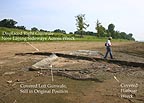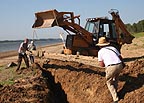September 11, 2007
Faculty, students again help save flatboat

Caption follows story
For more than 100 years, flatboats traveled American waterways with their passengers and loads but at journey's end, the vessels were broken up and sold for lumber with none preserved for future generations to see. However, local resident John Schwegman informed SIUC researchers a few years ago about the existence of a submerged flatboat near Olmstead in the Ohio River just miles from its convergence with the Mississippi River.
It took more than a year to get the necessary permits and property access permissions. When the river level dropped, Mark J. Wagner, an archaeologist with SIUC's Center for Archaeological Investigations, then led the preservation effort along with Robert H. Swenson, associate professor in the School of Architecture. The flatboat is the only known example remaining of more than 100,000 of the shoebox-shaped flatboats built in America. Archaeologists and other SIUC volunteers mapped and documented what was left of the flatboat.
Flatboats, used from about 1780 to 1900 on the Ohio, were the main way pioneers transported crops and other commodities to market in the early 1800's. The pioneer water crafts carried emigrant families and produce down the Ohio and Mississippi rivers.
Surprisingly, at the site near Mound City, researchers found about half of the bottom of the original 1800's era Olmsted boat. The flatboat was originally about 45 feet long and 12 feet wide. Named in honor of the old river town near where it was found, the flatboat's moniker is "America." One of the 45-foot long gunwales (upper edge of the boat's side) remains almost intact, as is part of the other. Builders split a tree to form the gunwales and used wooden pegs rather than nails to assemble the oak boat. That construction didn't match previous written accounts so the historic find has given a unique peak at unknown history.
Based on artifacts recovered from the wreck, it appears "America" dates to about 1801-1830, near the beginning of the flatboat era, according to Wagner. A 200-year-old oak was likely felled to construct the boat.
Eventually, the group hopes to remove and preserve for posterity in a museum the heavy, massive wooden flatboat pieces. Doing so requires extensive effort and considerable cost since the pieces must be transported and soaked for up to a year to replace the water with polyethylene glycol. Simply drying the wood would result in warping and cracking while putting it in pond water would allow bacteria and organisms to grow that would destroy it.
In the meantime, workers covered the boat remains with heavy, weed-guard black fabric, weighed it down with gravel and re-submerged it on the Ohio riverbank to keep it intact and stable until resources are available for permanent preservation. That plan worked for a few years. But when the water levels dropped this summer, local residents Nick Niestrath and Chuck Kesler noticed that the large log gunwale had washed out of place and was lying horizontally across the rest of the wreck. They quickly called in Wagner and Swenson to evaluate the situation.
Without quick action, they concluded all could be lost, as rising waters would pull downstream the dislodged gunwale, already bent and cracked but fortunately temporarily caught and lodged against the shorter left gunwale. Meanwhile, Wagner said the rest of the wreck is still covered and doesn't appear to be in any imminent danger.
With emergency funding from the Landmarks Preservation Council of Illinois, Wagner and Swenson returned to the site along with volunteers Bill Black Jr., of Paducah, Fred Keller of Cape Girardeau, and Matt Swenson of Carbondale. Using a backhoe, operator Mike Story dug a trench approximately 45-feet long by 36-inches wide. Workers first applied a pair of 15-foot long, treated-lumber splints alongside a cracked portion of the gunwale, hoisted the 1,000-1,2000 pound gunwale, and lowered it carefully into the trench. They placed a protective fiberglass mat on top and covered it with river gravel from a nearby gravel bar, thus keeping the Flatboat America archaeological site intact. Lifting ropes were left in place along with locator pins, so when additional preservation funds are available, the ship can more easily be removed and relocated for future generations to see and appreciate, Swenson said.
The latest efforts are part of the continuing short-term preservation solution as they seek to have "America" listed a one of the Landmarks Preservation Council's 10 most-endangered architectural sites in Illinois. The ultimate goal, according to Wagner and Swenson, is securing additional grants to remove the wreck from the riverbank, apply conservation treatment to the wooden framework, and display it in a museum somewhere in the lower Ohio River valley.

Caption 2 below
Caption 1: Flatboat uncovered — Robert Swenson, associate professor in the Southern Illinois University Carbondale School of Architecture, looks over the uncovered and partially displaced Flatboat America prior to the newest efforts to preserve the only known remaining flatboat in America. The flatboat, located near “America” and Olmstead along the Ohio River, dates to the early 1800’s. The nearly intact gunwale was in danger of floating downstream and being forever lost when river levels rise. With emergency grant funding from the Landmarks Preservation Council of Illinois, SIUC faculty and volunteers worked to stabilize the boat.
Photo provided
Caption 2: Flatboat stabilization — Matt Swenson of Carbondale, SIUC Center for Archaeological Investigations archaeologist Mark J. Wagner, backhoe operator Mike Story of Alexander County, preservation contractor Bill Black Jr. of Paducah, and Robert Swenson, associate professor in SIUC’s School of Architecture (unseen, holding rope at left) work to carefully hoist the 1,000-1,2000 pound gunwale and place it into a prepared trench. They then covered it with a protective fiberglass mat and weighed it down with river gravel to keep it in place until they can secure funding to permanently preserve the flatboat for museum display.
Photo provided
